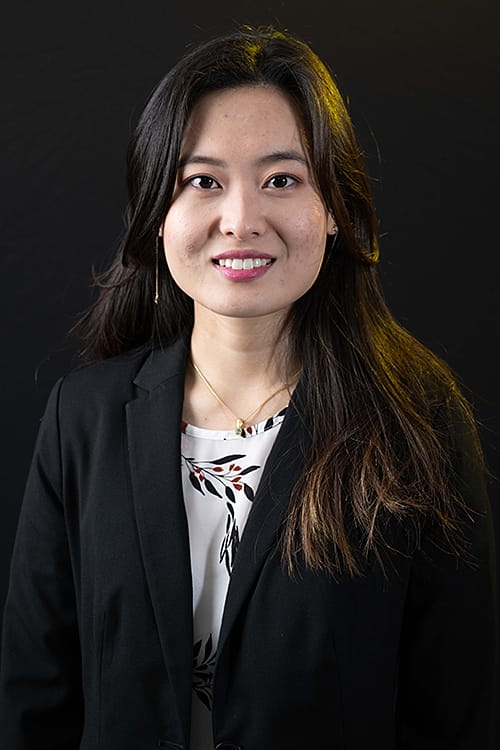
Mary Young, DDS student
Investigates facial bone development
“Mary is quiet and humble — a team player who is more about the team than about Mary…I find that Mary is always willing to lend a hand when I need assistance. Not only is she willing, but also with a smile on her face.” -Teresa Marshall, professor, preventive and community dentistry
Hometown: Qingdao, China/Iowa City, Iowa
Faculty mentor/advisor: Faculty Mentor: Azeez Butali, DDS, PhD, professor, oral pathology, radiology, and medicine. Advisor: Teresa Marshall, PhD, RD/LD, professor, preventive and community dentistry, College of Dentistry
What is your degree program and expected graduation date? Degree Program: Doctor of Dental Surgery (DDS). Expected Graduation Date: spring 2024.
Please describe your research: This past summer, I had the honor of doing a research internship at the National Institutes of Health in Bethesda, Maryland where I worked on developing a novel tool to investigate neural crest cell fate decisions. Neural crest cells are embryonic cells that migrate throughout the body and contribute to the formation of many structures, mostly associated with the nervous system. I designed a test that allows live visual tracking of neural crest development and differentiation into osteoblasts, the cells that form bones. My research over the last eight years at the University of Iowa under the mentorship of Dr. Butali has been in trying to understand the role of genes in orofacial clefts, a gap in the upper lip and or roof of the mouth of newborn babies, through identifying and studying genetic variations in multi-ethnic populations from all over the world.
In simple terms, why does this research matter? For my NIH project, our goal is to use the test to study the mechanisms behind neural crest cell fate decisions and identify candidate targets for improved bone regeneration. For my orofacial cleft projects, facial abnormalities impose significant social, psychological, and financial burdens on affected individuals and their families. Additionally, these congenital birth defects can result in early life complications, drastically increasing child mortality risk. Although several treatment options exist, access and affordability pose major barriers to care. Through pursuing this research, we hope to continue working towards contributing novel data to the ever-growing pool of knowledge that can be used for the improvement of genetic counseling for families afflicted with craniofacial abnormalities and the possible prevention of these diseases.
How soon after starting at the University of Iowa were you able to participate in research? I began volunteering in Dr. Gina Schatteman’s lab the summer after 8th grade doing general lab maintenance because I wanted to learn more about what research was like. From there, Dr. Martine Dunnwald allowed me to work in her lab the following summer doing data entry–here my interest in craniofacial abnormalities was born. I was introduced to my current mentor, Dr. Azeez Butali, and immersed into orofacial cleft research during the summer after my junior year of high school. I have continued doing research with Dr. Butali ever since then, all the way through my undergraduate program here at Iowa and presently in dental school. Within the dental curriculum, I currently do research during my summer breaks under the mentorship of Dr. Butali within the Dental Student Research Program led by Dr. Teresa Marshall. I am truly blessed to have received the support of so many incredible mentors thus far in my career.
How has being involved in research made you more successful at the University of Iowa? It often takes a village to make a scientific discovery. At the forefront, being involved in research has shown me the joys of working on a team and given me inspiration at every turn from those around me to always think critically and seek deeper truths to all of life’s questions. Through participating in research, I have learned how to become a better scientific communicator and experienced the absolute masterclass of honor, integrity, and innovation that has been showcased by all of the mentors I have had the privilege of working with. Also, the opportunity to work alongside scientists from many backgrounds and disciplines has been extraordinary and eye-opening. Across all fields, the development of solutions to specific diseases is a prime example of how science and medicine intersect to make the world a better place. Having the opportunity to conduct research at the University of Iowa has opened my eyes to opportunities that I never thought possible, and through the projects I have pursued and the people I have met, I continue to be inspired every single day to lead a life for the meaningful betterment of others.
What are your career goals and/or plans after graduation? Along with concurrently seeking out research opportunities alongside my education, my long-term career goals include pursuing a path that would allow me to continue working in the field of craniofacial abnormalities. In addition to the scientific discovery side, my hope is to also develop relevant clinical skills to even more impactfully treat craniofacial abnormalities. With the additional background in craniofacial genetics research, I would be in a unique position to both investigate disease etiology and prevention and treat craniofacial abnormalities clinically. I am passionate about a lifetime commitment to evidence-based care, as new discoveries made can alleviate and even prevent diseases in years to come, leading to better clinical dentistry and improved patient care.
Banner location: not on display—
